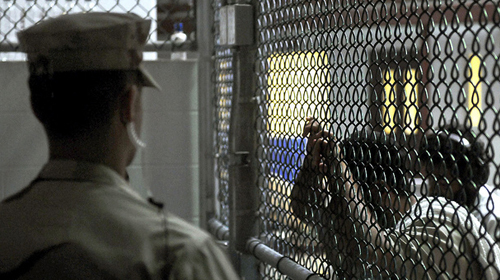Force-Feeding at Guantánamo Must End, As Should the Injustice Driving the Hunger Strike


As we have been writing in the past few weeks, the hunger strike in Guantánamo has expanded rapidly. The strike is rooted in the prisoners’ despair that the end of their days will come inside a Guantánamo cell, despite the fact that many have long been cleared for release. The situation has gotten so grave that the military says 23 of the at least 100 prisoners on strike are being force-fed. But what exactly is force-feeding? And why has it been rejected as medically unethical?
Dr. Gerald Thomson, former president of the American College of Physicians and member of the Constitution Project’s non-partisan Task Force on Detainee Treatment, which recently released a powerful report calling for the closure of Guantánamo, has said:
You know that the Task Force came out very strongly condemning force-feeding and this is in keeping and in line with international ethical standards both of professional treatment of hunger strikers and the ethics of treating hunger strikers. We do not believe that force-feeding should be an approach to the hunger strike. If you can imagine being a detainee and using refusal to eat as a form of protest and then you are forced to eat, forced physically to eat, by being strapped into a specially-made chair and having restraints put on your limbs, your arms, your legs, your body, your head so that you cannot move. Having a tube inserted into your throat that extends into your stomach and you’re trying to resist that with the only muscles that are free in your throat. Pain, discomfort, obviously. But in addition to that, food is then forced in a liquid form into your stomach. You’re kept in the chair for at least two hours, usually more than two hours, to prevent you from vomiting and undermining the force-feeding. You can’t go to the bathroom during that time. Your dignity is taken away.
The World Medical Association and international officials have clearly identified that process as cruel, inhuman and degrading treatment. And given the level of brutality it could extend to torture.
Now since you’re refusing food, that’s going to happen to you twice a day. Day after day, month and week after week.
You can watch his full remarks here:
https://youtu.be/nOhGczM42wM
By playing the YouTube video above, YouTube will place a permanent cookie onto your computer.
The American Medical Association wrote last week in a letter to Secretary of Defense Chuck Hagel:
[T]he forced feeding of detainees violates core ethical values of the medical profession. Every competent patient has the right to refuse medical intervention, including life-sustaining interventions.
The International Committee of the Red Cross, which has been regularly visiting Guantánamo since early 2002, agrees.
In February 2006, five independent United Nations human rights experts found that the force-feeding used in Guantánamo, essentially the same process used today, amounted to torture as defined in Article 1 of the Convention Against Torture. Later that year, responding in part to force-feeding in Guantánamo, the World Medical Association explicitly stated that “force-feeding contrary to an informed and voluntary refusal is unjustifiable” and “never ethically acceptable.” We made just these points to then-Secretary of Defense Robert Gates at the outset of the Obama administration. But the abuse continues.
Samir Naji al Hasan Moqbel, a prisoner in Guantánamo since 2002, who is on hunger strike, described what force-feeding feels like from a prisoner’s perspective:
I will never forget the first time they passed the feeding tube up my nose. I can’t describe how painful it is to be force-fed this way. As it was thrust in, it made me feel like throwing up. I wanted to vomit, but I couldn’t. There was agony in my chest, throat and stomach. I had never experienced such pain before. I would not wish this cruel punishment upon anyone.
Immediate action by the administration may mean an end to the hunger strike. President Obama yesterday renewed his commitment to close Guantánamo and end the indefinite imprisonment of the men held there. As the ACLU, Senate Intelligence Committee Chair Dianne Feinstein, the New York Times editorial board, and others have stated, there are two things the president could do today if he wanted. One is to name a senior point person so that the administration’s Guantánamo closure policy is directed by the White House and not by Pentagon bureaucrats. The other is to order the secretary of defense to start certifying prisoners for transfer who have been cleared – more than half the Guantánamo population. (This includes over 50 Yemenis, whose transfer has been blocked by a moratorium imposed after the attempted Christmas Day bombing in 2009. Senator Feinstein, who initially called for the moratorium, and who as head of the Intelligence Committee has access to in-depth information on the situation in Yemen, has now asked for a re-assessment of whether transfers to Yemen can take place).
The president should not stop there, but these are the two essential first steps. Without such action, by all indications, the hunger strike – and unethical, cruel force-feeding – will continue.
Learn more about Guantánamo Bay and other civil liberty issues: Sign up for breaking news alerts, follow us on Twitter, and like us on Facebook.

